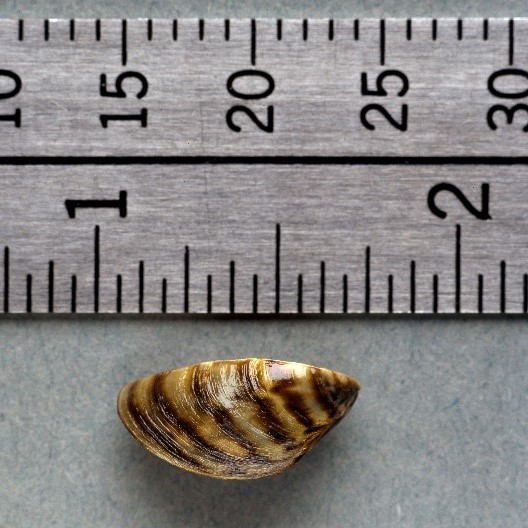Prevent the Spread of Mussels: Clean, Drain, and Dry
Clean, drain, and dry your watercraft to prevent spread of quagga mussels. 
As boating season kicks off, DWR, California State Parks’ Division of Boating and Waterways (DBW), and California Department of Fish and Wildlife (CDFW) urge boaters to always remember to clean, drain, and dry their boats before entering and leaving lakes, rivers, and other waterways to help prevent the spread of quagga or zebra mussels.
The two non-native freshwater mollusks – quagga and zebra mussels – pose a serious threat to California’s waters and ecosystem. Quagga and zebra mussels are small, invasive species that attach onto hard surfaces, such as boat hulls and pontoons, docks and pilings, rocks, concrete, plastics, and even discarded bottles and cans.
Quagga and zebra mussels can be spread to new waterbodies when attached to boats as adults, or as microscopic juveniles in water in motors, bilges, and livewells. They are smaller than a dime, and juvenile mussels may even be difficult to detect with the naked eye. Despite their small size, they can cause major damage to water delivery systems, hydroelectric facilities and watercraft engines. They also alter ecosystems and negatively impact recreation. Mussels can colonize in watercraft engines or hulls and encrust docks and beaches.
To protect California’s State Water Project (SWP) water from these invasive aquatic species, DWR routinely monitors for these mussels and takes measures to prevent them from infesting SWP water. As part of DWR’s early detection monitoring program, DWR works with partner agencies, such as DBW and CDFW and routinely samples for adult and juvenile (veliger) mussels at 18 SWP locations. Warning cards are distributed at eight SWP reservoirs to alert California boaters to the harmful effects of invasive mussels on boats and aquatic ecosystems.
Please help us stop the spread of mussels – awareness is the first line of defense, and boaters can help make a huge impact.
When boating, make it a habit to do the following:
- Remove all plants and animal material from your boat, trailer, and equipment
- Wash the hull of your boat or other watercraft thoroughly, preferably with high-pressure hot water
- Clean your gear before entering and leaving the recreation area
- Drain bilge, ballast, wells, and buckets before you leave the area
- Inspect all exposed surfaces - small mussels feel like sandpaper to the touch
- Dry equipment before launching into another body of water
- Allow at least a seven to eight day dry-out period before entering another body of water
Watercraft must pass an entrance inspection before launching in most SWP reservoirs, including Lake Del Valle, San Luis Reservoir, O’Neill Forebay, Los Banos Creek Reservoir, Pyramid Lake, Castaic Lake & Lagoon, Silverwood Lake, and Lake Perris.
If watercraft fails an entrance inspection or has been in an infested waterbody, it must observe a seven to eight day dry-out period before a boat can be launched in SWP waters. Dry time requirements vary for other waterbodies, so it is best to check before you go.
In California, it is illegal to import, transport or possess live or dead quagga or zebra mussels. Report any mussels you find to the local marina and the CDFW hotline at (866) 440-9530 or email: invasives@wildlife.ca.gov. For more information on invasive species laws and regulations, visit CDFW's website.
Mussels were found in the SWP in 2016 at Pyramid Lake and in 2021 at Castaic Lake. Pyramid and Castaic lakes are classified as infested.
In 2007, the first quagga mussels were discovered in the Colorado River at Lake Mead, Lake Mohave, and Lake Havasu. In 2008, zebra mussels were found in San Justo Reservoir in San Benito County. Check out a history of mussel sightings in California. Learn more about quagga and zebra mussels on the Department of Fish and Wildlife website and on the Division of Boating and Waterways website.
